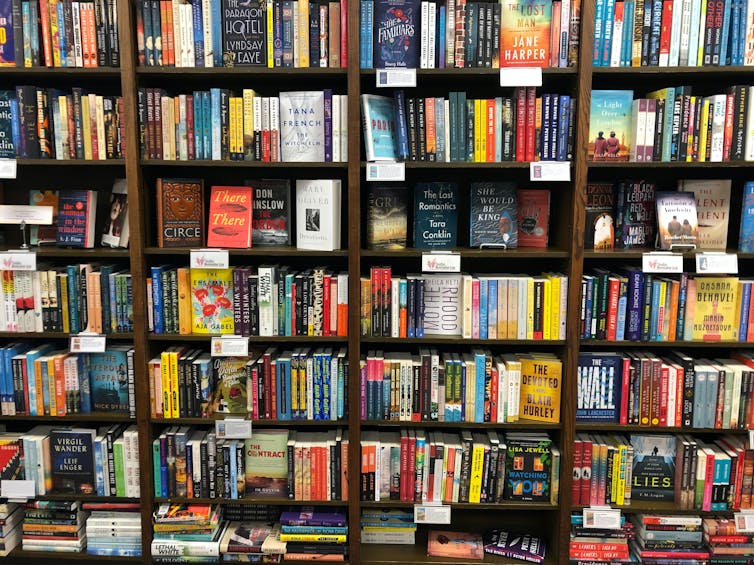One day each October, the UK publishing industry focuses its attention on a large number of high-profile new book releases. “Super Thursday”, as it is known in the trade, is the start of a seasonal promotion during which authors battle for space inside bookshops and under Christmas trees.
The timing is important, as the book-selling business is highly dependent on the festive season, with the final quarter of the year contributing substantially to annual sales. And while this year’s super Thursday (October 14) will see fewer publications than previous years, it still boasts nearly 300 new hardbacks.
Major titles include a memoir from comedian Billy Connolly, a posthumous spy novel from John le Carré, and a children’s book from Julia Donaldson. And there is good reason for these writers and their publishers to be optimistic.
Although COVID-19 has meant challenges for the industry, recent industry figures indicate a marked increase in appetite for books and reading. Despite bricks-and-mortar bookshops being closed for much of 2020, over 200 million print books were sold in that year – the highest number since 2012. The overall value of UK publisher sales in 2020 was £6.4 billion, 2% higher than 2019 figures.
A change in reading habits during lockdowns and periods of social restrictions may well have been responsible for this increase. Many people turned to books for entertainment, with some doubling the amount of time they spent reading. Genres including classic literature, crime and thrillers, self-help, cookery and hobbies proved particularly attractive.
But are these reading rates and soaring book sales sustainable as the world opens up again to other leisure activities? Certainly some of the signs are good, with a recent national “Bookshop Day” reportedly generating high footfall and record-breaking sales.
Yet at the same time, there are serious supply-chain issues on the horizon, exacerbated by both Brexit and COVID-19. The industry is also still dealing with the huge disruption caused by the arrival of big tech companies into the marketplace.
The biggest of these is of course Amazon, which swiftly moved from printed book sales and distribution to a seamless connection between e-book software and Kindle hardware. It has since evolved to provide self-publishing platforms, while it analyses reader-behaviour data using algorithms after acquiring the popular reading website Goodreads.
Page turner
The publishing industry suffers from habitual anxiety that people are no longer interested in buying and reading books; an existential sense of crisis that the buoyant figures of 2020 and 2021 should at least partly dispel.
Yet threats from those “digital disrupters”, problems with production and distribution, and concerns about post-Brexit copyright law, mean that optimism can be in short supply in the publishing industry, despite recent successes.
To assess whether the future for UK publishing is bright requires a finer-grained analysis. The publishers that did particularly well in the conditions of lockdown were the larger and longer-established ones. Smaller independent companies, against whom the odds are already stacked, struggled more.

Unspalsh/Renee Fisher
But these new companies are crucial to the continuing development of the industry. They are often more innovative in terms of the types of books they commission, the authors they work with, and the audiences they cater to.
Publishing in the UK still has an overwhelmingly white and middle-class labour force, as well as being geographically centralised in southern England.
And while tech companies might unsettle publishing’s traditional business practices, they can also offer platforms to communities and voices that the industry’s gatekeeping practices only rarely let through. Self-publishing platforms such as Wattpad offer successful alternative models, which can lead to global audiences and business deals.
Wattpad’s own figures indicate 90 million monthly users spending 20 billion minutes on the platform every month. But perhaps their most significant statistic is that 90% of the platform’s audience are readers under 40.
This level of engagement with such platforms suggests that writing and reading are far from dead, even if the emerging business models that attract some readers present a challenge to the traditional publishing industry.
To understand fully whether book publishing is sustainable, we need to think beyond economic considerations of mainstream business. Instead, we should take into account sociological patterns of writing and reading, and the platforms that enable or inhibit them.
As the pandemic has shown, reading is still an activity highly valued by millions of people, particularly in situations of stress and increased – but also constrained – leisure time. As the publishing industry emerges, it is undoubtedly sustainable – but the precise shape of its future is both uncertain and open to radical new forces.![]()
Claire Squires, Professor in Publishing Studies, University of Stirling
This article is republished from The Conversation under a Creative Commons license. Read the original article.
Photo by Seven Shooter on Unsplash
DIGITAL TRENDS
Stay up to date with digital trends
We cover latest trends all things digital with news and infos about developments for your online business.
